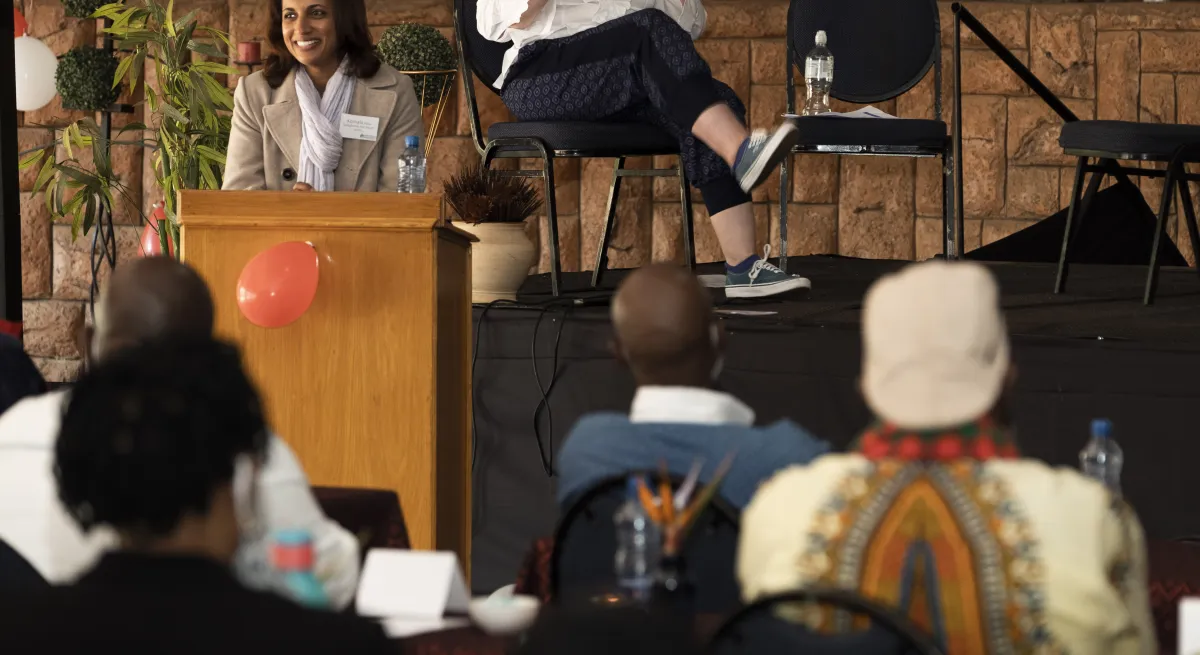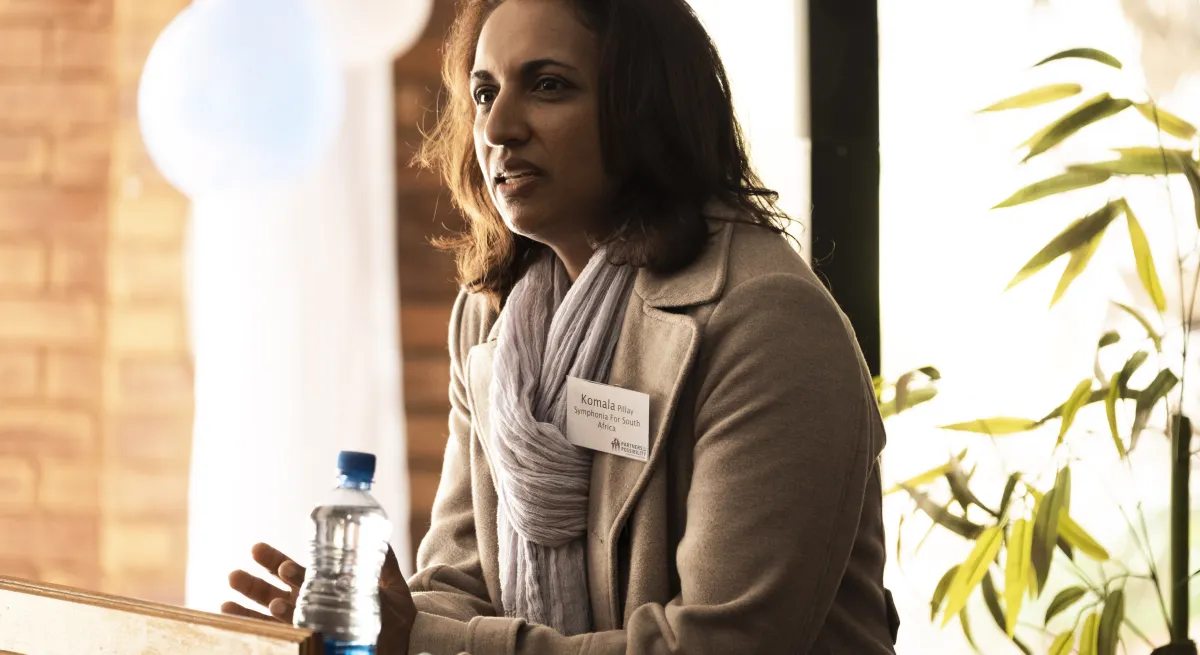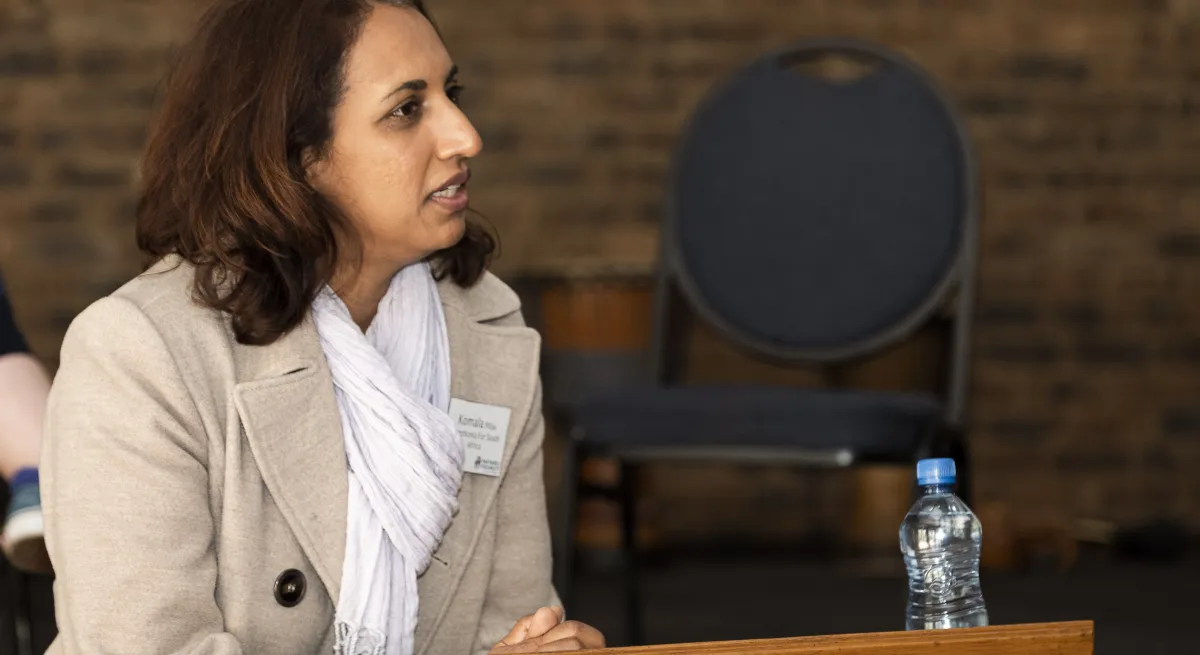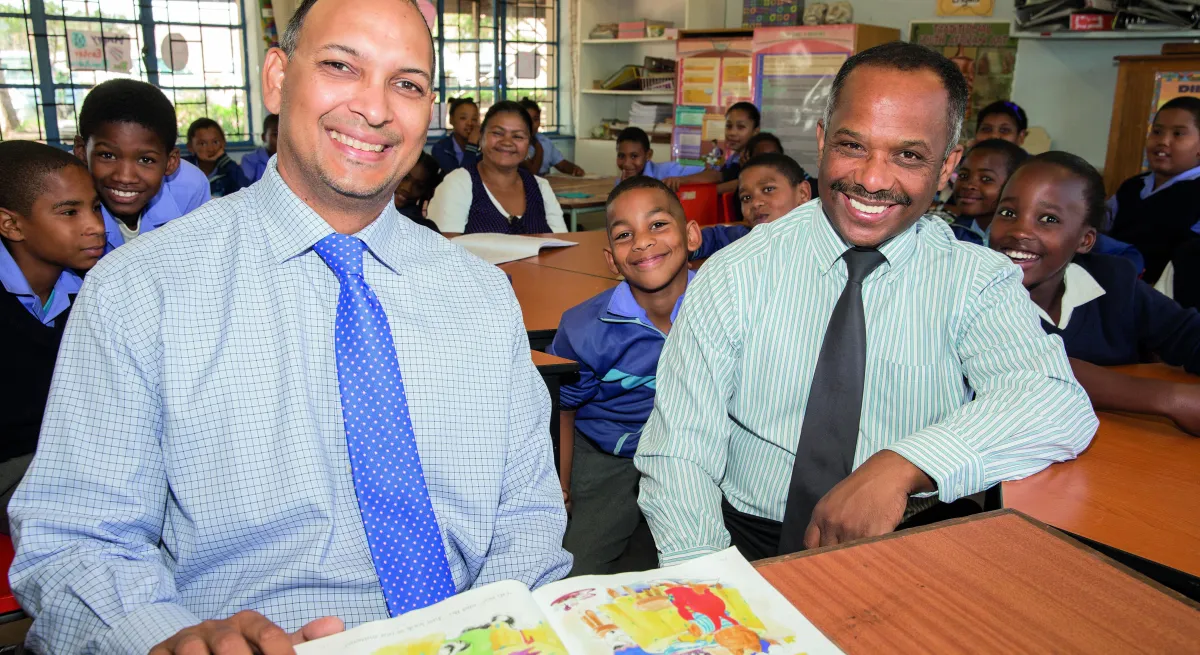In South Africa – one of the most unequal countries in the world – 50% of children do not have any educational degree. The organisation ‘Partner for Possibilities’ couples business leaders with school principals from underprivileged areas to address challenges in their school. Programme Director Komala Pillay explains how the PfP-approach goes beyond education to address the wealth gap and why the feeling of connection is vital for the survival of a nation.
Please tell us a little bit about yourself.
My name is Komala Pillay. I am the programme director of Partner for Possibilities. Before that, I was working for 20 years in the petrochemical industry: ten years as a chemical engineer, ten years on the business side. I was very fortunate in my life: When I started at the company, I was granted a studentship which allowed me to study. First in South Africa, then, in the Netherlands. Thanks to that, I’ve enjoyed an international career, working in Germany and across Europe for many years before I returned to South Africa. I guess this is why I now have a passion for education.
What is ‘Partners for Possibility (PfP)’ ?
‘Partners for Possibilities’ is an organisation which couples business leaders with school principals into a 12-month leadership programme. They’ll work in a co-partnership to address challenges in the principal’s school. This benefits both sides: The school principal receives support and learns organisational skills that help establish a safe and nurturing learning environment. At the same time, the business leader dives into a new world; he or she learns not only about the complexity of teaching in such an environment, they also learn about ‘the others’ in their country. In South Africa, most of us living in a wealthy neighbourhood are afraid to go into the poor neighbourhoods. We think we are going to get hijacked, we are going to get … [pauses]… robbed and so on. I have been going to my principal’s school now for two years and I’ve never had any incidents. The people I engage with are wonderful people. So, going out there, seeing the reality and unlearning all those stereotypes about ‘the others’ is not only eye-opening for the business leader, it is vital for a cohesive society.
What was the community’s initial reaction to PfP?
When the project started people didn’t understand why our focus was on the principals. Traditionally, most support programs are aimed at learners. But there’s many puzzle pieces that must come together for an effective learning environment. A few examples: First, learners must get proper nutrition to be able to concentrate. Learners must feel safe; if there’s a gun shooting in the streets, the children must feel secure inside the school. Learners need good teachers who, in turn, need support and motivation. All these pieces must be put together by the principal. Ten years ago, this perception wasn’t understood at all.
Another scepticism was: Why do they bring in businesspeople who have no experience in education? What are they going to do in the schools? Are they going to take over, actually disempowering the principal? That’s the opposite of what we want. The business leader empowers the principal with different resources: social capital, networks, skills in HR, Finance, IT, leadership. The principal still makes the decisions, and the business leader helps him or her establishing it all.




Being a principal shouldn’t be a hazardous job.
How has community life changed since ‘Partners for Possibilities’ started?
The first level of change we look for is with the principals. The environment of these public schools is tremendously difficult: resigned teachers, uninvolved parents, school boards distrusting change, and all of it in a precarious environment. In my corporate career, I haven’t had a challenge half as hard as theirs. We had a principal who was assassinated, just because of friction between the community and the school. Being a principal should not be a hazardous job. So, our first goal is to get the principal in a good space.
The principals who come out of the PfP-programme report feeling more positive about the future. They are more energized. They learn how to trust and how to listen to other people, how to delegate and how to get a supporting team behind themselves. With that achieved, we see changes on all the other levels: better collaboration from the school board, less absenteeism of teachers and increased parental involvement; parents trying to learn how they can fulfil their role as an educator in their child’s life. We have also observed an improvement of learning outcomes in literacy and math. Unfortunately, we don’t have enough research on that yet as these studies are long-term and costly. Interestingly enough, we also see more funding going to schools with PfP-principals. Funders want to see that their money goes to someone who makes good use of it, our principals seem to be good at demonstrating that.
What is South Africa to you?
South Africa is home. It’s where my heart is. There’s an amazingly diverse nature, which is where I get the food for my soul. But what makes South Africa so special to me: it’s made of people with interesting stories; people who came from somewhere else looking for a better life. So, we have a diverse spread amongst South Africans. Then, there’s also our very difficult history. Going through difficult times does something to people. It can be negative, but when I look at South Africans, I see people who can solve problems and who can overcome difficult situations.
What are current problems of South Africa?
We tend to forget what we can do as a nation. We used to solve our problems on our own but now we have become a bit apathetic. We are often looking for someone else to solve our problem. Instead, we should remember the strength and fortitude we have precisely because we’ve battled apartheid.
We are building high walls, but high walls just reduce the quality of our own life. We are not made to be disconnected.
However, what worries me most: we run the risk of becoming disconnected from each other as South Africans. Our new separation is social class – the wealth divide. In South Africa, if you have wealth, you tend to try protecting yourself, you become self-focused. You live in a house with high walls, you don’t see your neighbour anymore, and you form this cocoon. It feels like the safest thing to do but it actually means being isolated and disconnected. Same thing in global politics: nationalism, protectionism, it’s all increasing. People want to just take care of themselves and their small community. We are building high walls, but high walls just reduce the quality of our own life. That’s because human beings are gregarious, social creatures. We are not made to be disconnected.
What made you move from business into social change?
A few years ago, my partner and I realized, we are falling into that trap: we were building our cocoon and we noticed, we were actually very unhappy. So, we decided: this is not going to happen to us. We wanted to be in South Africa, we wanted to enjoy everything our country has to offer. That meant coming out of our high walls; it meant connecting with people. And the way to connect, is through contributing. If you find a way to contribute to society, you’ll find connection. Suddenly, the scary people from ‘this area’ or of ‘that race’ are not scary anymore. You start stripping your mind of these caricatures that had been created and you start seeing the real people behind.
How does wealth inequality affect a society?
Wealth inequality creates instability. In South Africa about 42% of our workforce are without jobs. 10% of them have stopped looking. 55% of people younger than 35 don’t have jobs. That’s a total 11 million people who could contribute to society but can’t find a way to do so. That is fatal. Because contributing to a society and receiving from it is what makes you a part of society. You follow its laws and societal rules because you are part of it. Now, if you are outside of society, with no possibility to participate, why should you follow those rules? If a large enough group, like 11 million people, starts thinking like that, it becomes disastrous. Not only to South Africa, to any society.
How do you tackle wealth inequality?
There are many important levers but for me, education is key. Because ultimately, what every human being wants is meaning, a purpose in life. Education is the prime opportunity to help people find their purpose. And it doesn’t even have to be a purpose that someone else creates. You don’t necessarily have to go work for someone. If we get the education right, people can create their purpose.
Why do you care? You have made it. You climbed to social ladder in your community. What is your key driver?
It’s interesting, I don’t think of myself as an altruist at all. If you want to take care of yourself, you’ll want to take care of the people around you. When it comes down to it, inequality matters to everyone. We’re all in it together – and that’s not my emotional argument, that’s purely rational thinking. Global warming for example: one person alone cannot fix it; we all need to fix it. We are fooling ourselves if we think we can build some cocoon to protect ourselves.
Last Question: Has your engagement at ‘Partners for Possibilities’ changed you?
Big time. I went into the school wanting to give, not at all expecting to receive. My principal – her name is Ilana Heradien– she’s an absolutely amazing individual. When I first did my programme with her, I was still working in corporate. The thing that gave me the most joy in that year, was going to the school and working with Ilana. Her attitude and her vision in the face of so many challenges are inspiring. It was awakening and humbling. There are such amazing people out there, who care so much. They give so much of themselves and it is a privilege to support them. But here’s what struck me most: On my first day at the school, I saw how the little children would walk up to Ilana and hug her. There was so much love. I realized, our public schools are often places where children feel safe and loved. Some might not have it at home, but they can have it at school. I also realized: That connection I was missing for so long? It was there, right in the middle of where I had never dared to go.
